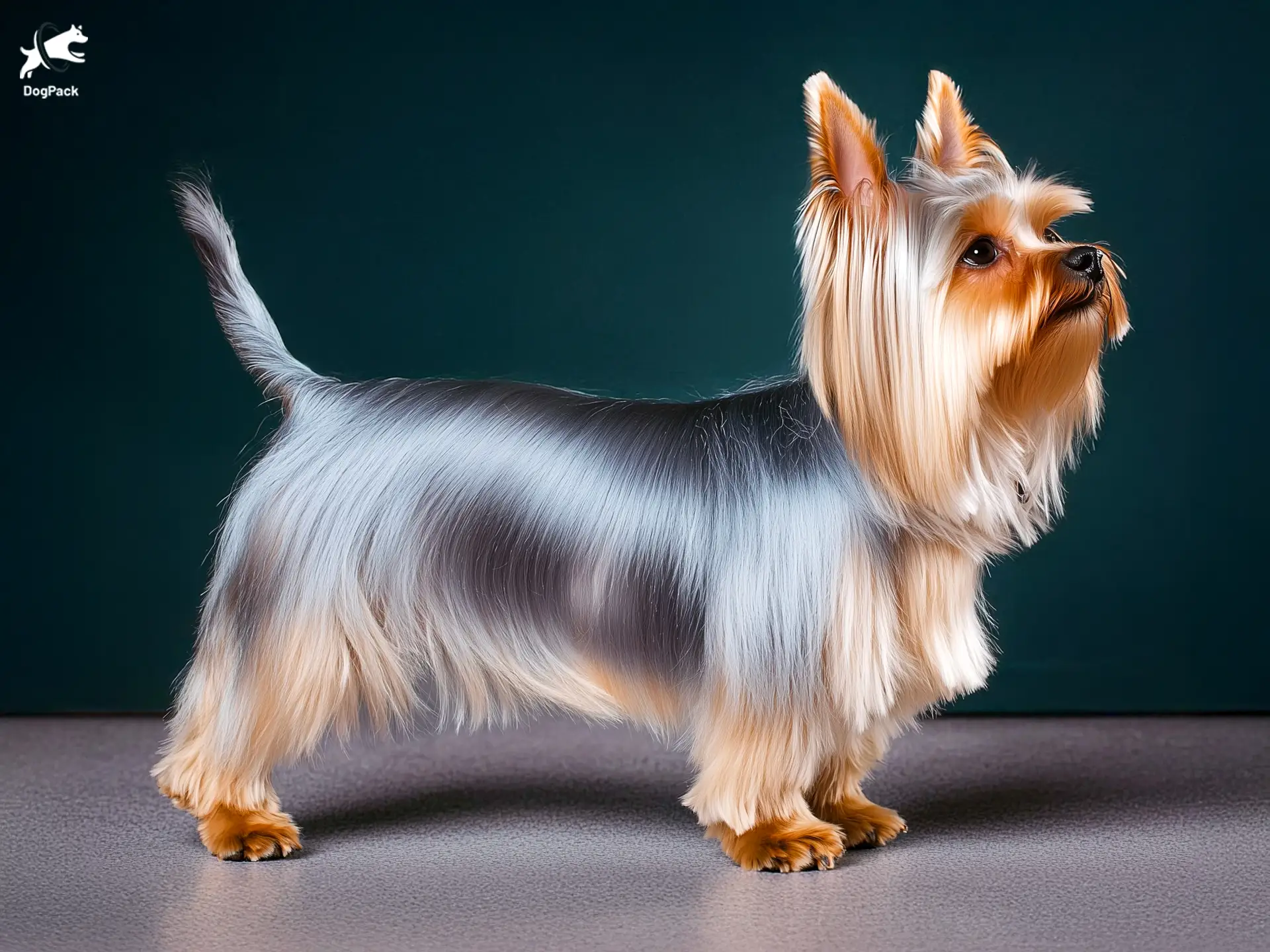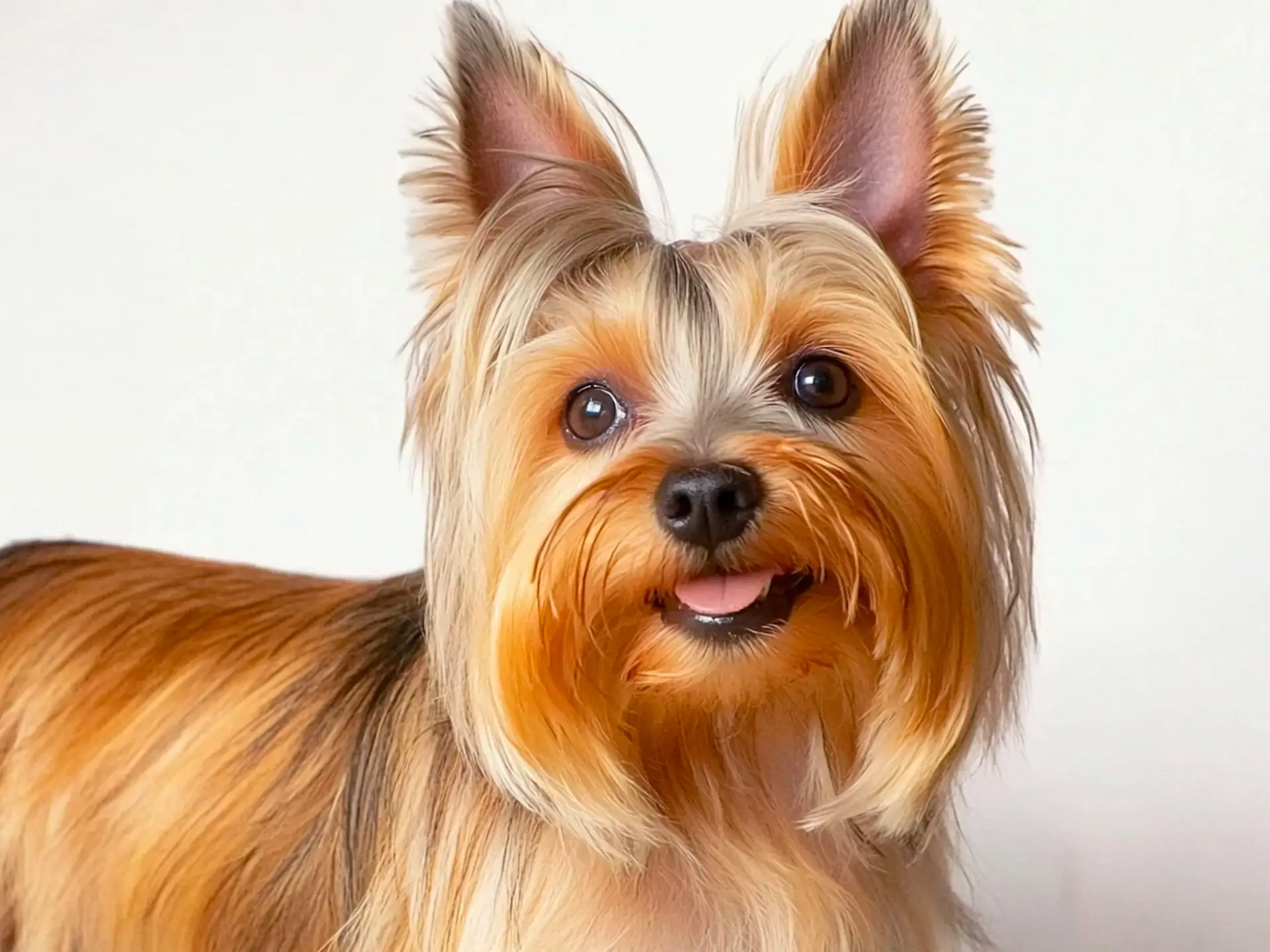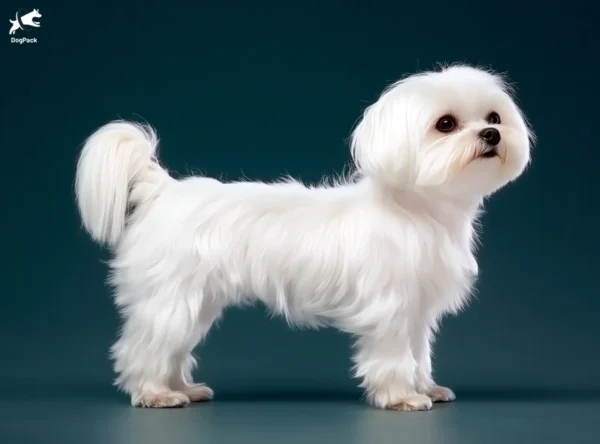Silky Terrier Dog Breed Info & Overview
Silky Terriers are bright, confident dogs best known for their flowing coats and spirited dispositions. They may be small, but they carry themselves with an elegant poise reminiscent of larger breeds. Whether you’re looking for a loyal lap buddy or an energetic walking partner, these smart little dogs pack plenty of personality into their petite frames.
Characteristics
Pictures
Breed History
Before earning a place in modern homes, these spunky pups originated in Australia in the early 1900s. They’re believed to have been developed by crossing the Australian Terrier and the Yorkshire Terrier, resulting in a small dog that combined lively energy with a sleek, silky coat. Early breeders prized them for their vermin-hunting abilities, especially in urban settings.
The Silky Terrier quickly gained popularity among city dwellers thanks to its compact size and feisty demeanor. Historians note that fanciers focused on preserving the terrier’s bold spirit while refining the coat’s distinctive texture. The breed’s name reflects its hallmark feature—soft, flowing hair that shimmers when groomed correctly.
In the mid-20th century, returning soldiers from World War II introduced the breed to the United States. From there, the Silky Terrier gained fans looking for a playful yet elegant companion. Over time, the breed standards were refined, and clubs dedicated to promoting Silky Terriers sprang up, celebrating their energetic personalities and fashionable appearances.
Temperament, Personality
A Silky Terrier often seems blissfully unaware of its small stature and will greet the world with unshakable confidence. These dogs love to be in the middle of family activities, happily tagging along to the park or curling up for an afternoon snooze. They thrive on companionship and may become lonely or anxious if left out for too long.
When well-socialized, Silkies can be quite friendly with visitors but will not hesitate to sound the alarm if something seems off. Their terrier roots shine through in their curiosity and occasional stubborn streak. Early training and consistent boundaries help channel this inquisitiveness into delightful, lively behavior rather than rowdy mischief.
These dogs can be a playful match for kids who understand how to handle a small, delicate breed. However, rowdy toddlers might overwhelm a Silky Terrier, so supervision is recommended. With other pets, especially cats, Silkies can learn to coexist peacefully—just be mindful of that terrier instinct which might spur them to chase smaller creatures if not properly introduced.
Physical Characteristics
Though petite in size, a Silky Terrier carries itself with a proud, almost regal bearing. The body is slightly longer than it is tall, giving a slender appearance that contrasts with a robust, terrier-like stance. A moderate bone structure and compact build allow for quick, nimble movement—ideal for the playful antics these dogs often display.
The hallmark of this breed is its coat: fine, glossy, and parted down the middle. Unlike the fluff of many toy breeds, a Silky Terrier’s fur drapes closer to the body, giving a smooth, elegant silhouette. The typical coat color includes shades of blue and tan, though slight variations are acceptable under breed standards.
Ears stand upright, contributing to the breed’s alert, intelligent look, and the muzzle is comparatively long for a toy-sized dog. Eyes are bright and inquisitive, reflecting the Silky’s curious spirit. Most individuals weigh between 8 and 10 pounds, so they’re definitely on the smaller side of small dog breeds, but they carry themselves like they’re twice as big.
Health Issues
Overall, the Silky Terrier is a relatively sturdy dog. However, like many purebred breeds, certain genetic issues can occur. Patellar luxation—where the knee cap can slip out of place—is one concern that owners should watch for, especially because this breed is small and active. Regular vet checks can catch early signs and help manage any discomfort effectively.
Tracheal collapse is another condition to be mindful of. This involves a weakening of the cartilage in the windpipe and can lead to a distinct “honking” cough. Owners may notice it more in dogs who become overweight or are allowed to tug excessively on a collar. A harness and controlled feeding schedule can help alleviate unnecessary strain.
Dental care is paramount for a Silky Terrier due to its narrow jaw and closely spaced teeth. Tartar buildup can quickly lead to gum disease if brushing isn’t part of the routine. Scheduling annual professional cleanings and performing regular at-home dental checks can save your pup from future extractions or infections.
Grooming Needs
Expect to devote consistent time to coat maintenance if you bring home a Silky Terrier. Their hair grows long and straight, resembling human hair more than typical dog fur. Daily or at least every-other-day brushing is ideal to prevent tangles, especially around the ears, legs, and tail. A wide-toothed comb can also help with stubborn knots near the undercoat.
Baths are recommended every three to four weeks to keep that silky sheen in top shape. Use a gentle, dog-specific shampoo and conditioner to avoid drying out the coat. After a bath, thorough drying with a cool air setting helps prevent frizz. Trimming the hair around the feet and hygiene areas can reduce matting and keep the dog comfy.
Because the breed’s coat is low-shedding, frequent grooming is vital for maintaining a healthy shine. Pay special attention to the ears, as they stand erect and can accumulate dirt. Clipping nails once or twice a month is also important—long nails can lead to discomfort and an altered gait. A patient approach and plenty of treats make grooming sessions more enjoyable.
Exercise Requirements
Despite their small size, Silky Terriers have a fair bit of energy to burn. A brisk daily walk of 30–45 minutes suits them well. If you skip these outings, don’t be surprised if your buddy starts finding ways to entertain itself—possibly by barking at every noise or rearranging the contents of your sock drawer!
Interactive play sessions, like chasing a ball or tugging on a small rope toy, help the breed stay both physically and mentally active. Because of their inquisitive nature, Silkies often enjoy puzzle toys where they can sniff out treats. Short bursts of agility exercises in your yard or living room can also challenge their quick reflexes and keep them engaged.
However, be mindful not to overdo it with high-impact exercises. Their delicate joints mean extended, vigorous activities like long-distance running are not ideal. Instead, frequent shorter walks or playful fetch breaks are more appropriate. And always keep a watchful eye—though they’re not large, they can dart off if something piques their terrier instincts.
Training Tips
Training a Silky Terrier is equal parts patience and consistency. While they’re eager to please, their terrier lineage can manifest as a stubborn streak. Positive reinforcement—especially using high-value treats or praise—goes a long way toward capturing their attention and building good habits. Avoid harsh corrections; they tend to respond better to encouragement than discipline.
Housebreaking can be smooth if you stick to a predictable schedule and celebrate small successes. If your Silky shows signs of nervousness, keep training sessions short and upbeat. This breed thrives on variety, so mixing up lessons with fun tasks like “spin” or “fetch the toy” can keep them invested in learning basic commands like “sit,” “stay,” and “come.”
Socialization is also key. Invite new friends or friendly dogs over in controlled settings, and expose your pup to different sounds and sights early on. Terriers can be chatty, so teach a “quiet” command if the barking gets out of hand. Overall, approach training consistently and calmly, and you’ll find your small companion absorbing lessons with surprising quickness.
Nutrition, Diet
The Silky Terrier thrives on a balanced, protein-rich diet tailored to small-breed dogs. Aim for formulas containing easily digestible meats like chicken or turkey as the first ingredient. Look for moderate fat content—these dogs need enough energy to maintain their spunky nature but shouldn’t become overweight. A specialized small-breed kibble size helps prevent choking and dental issues.
Most healthy adult Silkies do well with about ½ to ¾ cup of quality dry food daily, split into two meals. Because they’re prone to dental tartar, consider incorporating crunchy kibble or dental treats. Some owners add a spoonful of wet food or homemade broth for extra flavor, but watch calorie intake to keep their weight in check.
If your Silky Terrier is especially active or participates in agility, consult your vet about increasing protein levels. Supplements containing omega-3 fatty acids can also support their coat health. Should you notice weight gain or digestive upset, tweak the portion size or switch to a lower-fat formula. Always transition foods gradually to avoid tummy troubles.
Adoption, Breeders
When seeking a Silky Terrier, reputable breeders are your safest bet. They’ll provide health clearances for common conditions like patellar luxation and ensure each puppy’s well-being. Ask to see the pups’ living conditions and meet at least one parent on-site. A responsible breeder should be transparent and able to answer specific questions about this breed’s grooming and exercise needs.
If you prefer to adopt, check specialized rescues or shelters that focus on terriers. These organizations frequently have older Silkies in need of a loving home. Search resources like Silky Terrier Rescue and local humane societies. Many times, an adult dog’s temperament is already established, making it easier to find the perfect match for your household.
For more comprehensive breed information, you can explore the American Kennel Club’s Silky Terrier page or the Silky Terrier Club of America. These sites offer details on the breed standard, health testing, and upcoming events or meetups. Whether you choose a breeder or rescue route, patience in your search will pay off with the right canine companion.
Family Pet?
A Silky Terrier can make an excellent family companion, provided children are taught to handle this petite pup with care. Their affectionate nature often shines around gentle, older kids who respect boundaries. With proper socialization, the dog’s playful side thrives, making them eager participants in family games and a comforting presence during quieter moments.
It’s wise to supervise interactions with very young children, as Silkies can be startled by sudden movements or loud noises. Although generally good-natured, they might respond with a growl or snap if they feel cornered or handled roughly. Establishing basic household manners—both for the dog and the kids—usually paves the way for a harmonious relationship.
If you already have pets, gradual introductions are key. The Silky Terrier’s terrier instincts might spark a chase game with cats or small animals, but consistent training and patience can smooth over most hurdles. With the right approach, they’ll settle in as a spirited, devoted member of the household, always ready for a walk, cuddle, or lighthearted mischief.
Right For You?
If you’re looking for a small but confident companion, a Silky Terrier might be just the ticket. They bring plenty of charm to the table yet require a firm but gentle approach to training. Their grooming routine demands a bit more time, but the reward is a beautiful, low-shedding coat and a pup who adores being near its people.
Consider your schedule and living space. While they adapt well to apartments, they still need mental and physical engagement. Busy owners who can’t dedicate daily interaction might find their Silky becoming restless. However, those with a moderate activity level and a fondness for grooming sessions will likely be enthralled by this fashionable, fun-loving terrier.
Ultimately, Silkies thrive when they are actively involved in family life. If you want an alert little dog who can be both a playful friend and a snuggly companion, this breed could be ideal. Just be ready for their occasional bursts of stubbornness and big personality moments—you’ll soon see why so many people fall for this spunky Australian import.
Conclusion
If you’re seeking a lively yet affectionate companion, the Silky Terrier stands out as a wonderful choice. Their compact size and minimal shedding make them suitable for apartment living, and their sociable nature fits in beautifully with families, seniors, or solo owners who can devote the time they crave. A bit of extra grooming is a small trade-off for having a stylish, confident friend at your side, always ready to brighten your day.
FAQs
-
Why do Silky Terriers chase small animals so much?
Silky Terriers were originally bred to hunt vermin, giving them a strong prey drive. Their instinct to chase squirrels, birds, or even insects is natural. Training and leash control are essential to prevent them from darting after small creatures.
-
Do Silky Terriers have a distinct way of walking or moving?
Yes! Silky Terriers often have a confident, bouncy gait that showcases their spirited personality. Their movement is swift and agile, a trait inherited from their hunting ancestry, making them surprisingly fast and nimble for their size.
-
Why do Silky Terriers bury their toys or food?
Silky Terriers may instinctively “hide” their favorite items by tucking them under blankets or pushing them into corners. This behavior mimics how their ancestors stored food and protected their belongings in the wild.
-
Do Silky Terriers recognize their own reflection in mirrors?
Unlike some dogs that ignore or react aggressively to mirrors, many Silky Terriers display curiosity, often tilting their heads or barking at their reflection. Their high intelligence makes them more aware of their surroundings, including unusual visual stimuli.
-
Why do Silky Terriers tilt their heads when listening?
Silky Terriers have an expressive personality and a keen sense of hearing. They tilt their heads when listening to voices or sounds to determine the source and understand tone, making them seem even more attentive and engaging.
Breed Ratings
The Silky Terrier quickly picks up commands but may show a stubborn streak now and then.
This pup loves games and interactive toys, especially with active owners or older kids.
Moderate energy that’s satisfied with daily walks and the occasional zoom around the house.
Low-shedding but high-maintenance coat that requires frequent brushing.
Has the terrier instinct to chase smaller animals if not supervised or trained properly.
Frequent brushing and bathing are needed to keep that long coat tangle-free.
Eager to please yet stubborn; consistent, positive training methods are essential.
Can become anxious if left alone too often or for very long periods.
Tends to be vocal, especially when alerting to new sights or sounds.
Rarely drools, which is a bonus for neat-freak owners.
Generally friendly but needs proper socialization to ensure good canine manners.
Relatively healthy, but watch out for knee, tracheal, and dental issues.














